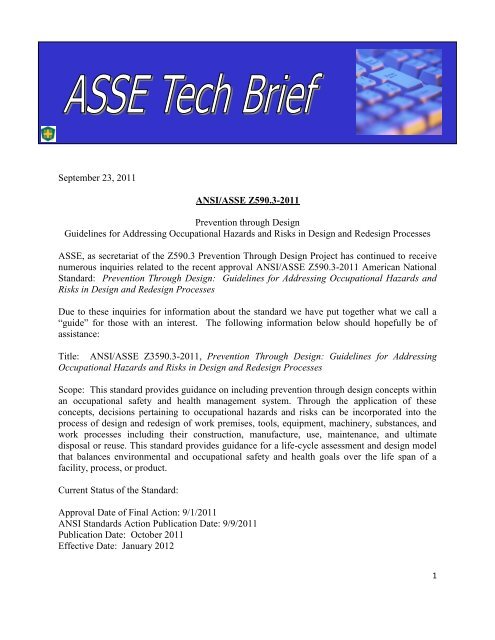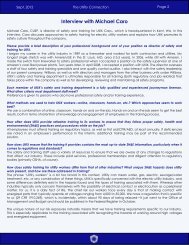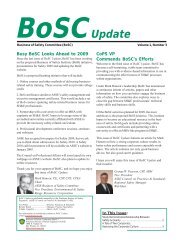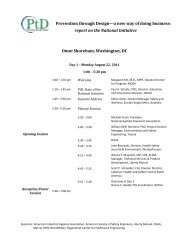Ansi/asse z590.3-2011 - American Society of Safety Engineers
Ansi/asse z590.3-2011 - American Society of Safety Engineers
Ansi/asse z590.3-2011 - American Society of Safety Engineers
You also want an ePaper? Increase the reach of your titles
YUMPU automatically turns print PDFs into web optimized ePapers that Google loves.
September 23, <strong>2011</strong><br />
ANSI/ASSE Z590.3-<strong>2011</strong><br />
Prevention through Design<br />
Guidelines for Addressing Occupational Hazards and Risks in Design and Redesign Processes<br />
ASSE, as secretariat <strong>of</strong> the Z590.3 Prevention Through Design Project has continued to receive<br />
numerous inquiries related to the recent approval ANSI/ASSE Z590.3-<strong>2011</strong> <strong>American</strong> National<br />
Standard: Prevention Through Design: Guidelines for Addressing Occupational Hazards and<br />
Risks in Design and Redesign Processes<br />
Due to these inquiries for information about the standard we have put together what we call a<br />
“guide” for those with an interest. The following information below should hopefully be <strong>of</strong><br />
assistance:<br />
Title: ANSI/ASSE Z3590.3-<strong>2011</strong>, Prevention Through Design: Guidelines for Addressing<br />
Occupational Hazards and Risks in Design and Redesign Processes<br />
Scope: This standard provides guidance on including prevention through design concepts within<br />
an occupational safety and health management system. Through the application <strong>of</strong> these<br />
concepts, decisions pertaining to occupational hazards and risks can be incorporated into the<br />
process <strong>of</strong> design and redesign <strong>of</strong> work premises, tools, equipment, machinery, substances, and<br />
work processes including their construction, manufacture, use, maintenance, and ultimate<br />
disposal or reuse. This standard provides guidance for a life-cycle <strong>asse</strong>ssment and design model<br />
that balances environmental and occupational safety and health goals over the life span <strong>of</strong> a<br />
facility, process, or product.<br />
Current Status <strong>of</strong> the Standard:<br />
Approval Date <strong>of</strong> Final Action: 9/1/<strong>2011</strong><br />
ANSI Standards Action Publication Date: 9/9/<strong>2011</strong><br />
Publication Date: October <strong>2011</strong><br />
Effective Date: January 2012<br />
1
The final version <strong>of</strong> the Z590.3 Table <strong>of</strong> Contents from the approved standard:<br />
Contents SECTION ................................................................................................. PAGE<br />
1. Scope, Purpose and Application ............................................................10<br />
1.1 Scope .............................................................................................10<br />
1.2 Purpose ..........................................................................................10<br />
1.3 Application ....................................................................................10<br />
2. Referenced and Related Standards .........................................................11<br />
2.1 Referenced Standards and Guidelines ..........................................11<br />
2.2 Referenced <strong>American</strong> National Standards and Technical Reports11<br />
3. Definitions..............................................................................................12<br />
4. Roles and Responsibility........................................................................14<br />
5. Relationships with Suppliers..................................................................15<br />
6. <strong>Safety</strong> Design Reviews ..........................................................................16<br />
7. The Hazard Analysis and Risk Assessment Process..............................17<br />
7.1 Management Direction..................................................................17<br />
7.2 Select a Risk Assessment Matrix ..................................................18<br />
7.3 Establish the Analysis Parameters ................................................19<br />
7.4 Anticipate/Identify the Hazards ....................................................19<br />
7.5 Consider the Failure Modes ..........................................................20<br />
7.6 Assess the Severity <strong>of</strong> Consequences ...........................................20<br />
7.7 Determine Occurrence Probability ...............................................21<br />
7.8 Define the Initial Risk ...................................................................21<br />
7.9 Select and Implement Risk Reduction and Control Methods .......22<br />
7.10 Assess the Residual Risk ..............................................................22<br />
7.11 Risk Acceptance Decision Making ...............................................22<br />
7.12 Document the Results ...................................................................23<br />
7.13 Follow Up on Actions Taken ........................................................23<br />
8. Hazard Analysis and Risk Assessment Techniques...............................23<br />
9. Hierarchy <strong>of</strong> Controls ............................................................................24<br />
Addenda:<br />
A – The Risk Assessment Process .........................................................27<br />
2
B – Progression <strong>of</strong> Occupational Hygiene Issues Flow Chart ...............28<br />
C – Procurement Guidelines ..................................................................29<br />
D – Risk Assessment Report..................................................................31<br />
E – A <strong>Safety</strong> Design Review Guide .......................................................32<br />
F – Examples <strong>of</strong> Risk Assessment Matrices and Definitions <strong>of</strong> Terms .34<br />
G – Comments on Selected Hazard Analysis and Risk<br />
Assessment Techniques ..................................................................40<br />
H – Potential Failure Mode and Effects Analysis Sequence .................44<br />
I – The Logic Supporting the Hierarchy <strong>of</strong> Controls ............................45<br />
J – Bibliography .....................................................................................50<br />
Below is the text from the first four pages <strong>of</strong> the standard:<br />
1. SCOPE, PURPOSE AND APPLICATION<br />
1.1 Scope. This standard provides guidance on including prevention through design<br />
concepts within an occupational safety and health management system. Through the application<br />
<strong>of</strong> these concepts, decisions pertaining to occupational hazards and risks can be incorporated into<br />
the process <strong>of</strong> design and redesign <strong>of</strong> work premises, tools, equipment, machinery, substances,<br />
and work processes including their construction, manufacture, use, maintenance, and ultimate<br />
disposal or reuse. This standard provides guidance for a life-cycle <strong>asse</strong>ssment and design model<br />
that balances environmental and occupational safety and health goals over the life span <strong>of</strong> a<br />
facility, process, or product.<br />
This standard complements but does not replace performance objectives existing in other specific<br />
standards and procedures.<br />
The goals <strong>of</strong> applying prevention through design concepts in an occupational setting are to:<br />
� Achieve acceptable risk levels.<br />
� Prevent or reduce occupationally related injuries, illnesses, and fatalities.<br />
� Reduce the cost <strong>of</strong> retr<strong>of</strong>itting necessary to mitigate hazards and risks that were not<br />
sufficiently addressed in the design or redesign processes.<br />
1.2 Purpose. This standard pertains principally to the avoidance, elimination, reduction or<br />
control <strong>of</strong> occupational safety and health hazards and risks in the design and redesign process.<br />
Note: Incidents or exposures that have the potential to result in occupational injuries<br />
and illnesses can also result in damage to property and business interruption, and<br />
damage to the environment. Reference is made in several places in this standard to<br />
those additional loss potentials which may require evaluation and resultant action.<br />
3
1.3 Application. This standard may be applied in any occupational setting. This standard<br />
applies to the four major stages <strong>of</strong> occupational risk management as follows:<br />
1. Pre-operational stage – in the initial planning, design, specification, prototyping,<br />
and construction processes, where the opportunities are greatest and the costs are<br />
lowest for hazard and risk avoidance, elimination, reduction or control.<br />
2. Operational stage – where hazards and risks are identified and evaluated and<br />
mitigation actions are taken through redesign initiatives or changes in work<br />
methods before incidents or exposures occur.<br />
3. Post incident stage – where investigations are made <strong>of</strong> incidents and exposures to<br />
determine the causal factors which will lead to appropriate interventions risk<br />
levels.<br />
4. Post operational stage – when demolition, decommissioning or reusing/rebuilding<br />
operations are undertaken.<br />
2. REFERENCED AND RELATED STANDARDS<br />
2.1 Referenced Standards and Guidelines.<br />
BS OHSAS 18001/18002, Occupational Health and <strong>Safety</strong> Management Systems –<br />
Requirements<br />
CSA Standard Z1000, Occupational Health and <strong>Safety</strong> Management<br />
ISO 12100: <strong>Safety</strong> <strong>of</strong> Machinery –General Principles for Design Risk <strong>asse</strong>ssment and risk<br />
reduction<br />
ISO/IEC Guide 51. <strong>Safety</strong> aspects – Guidelines for their inclusion in standards<br />
MIL-STD-882D, Standard Practice for System <strong>Safety</strong><br />
SEMI S2-0706, Environmental, Health, and <strong>Safety</strong> Guideline for Semiconductor Manufacturing<br />
Equipment<br />
SEMI S10-0307, <strong>Safety</strong> Guideline for Risk Assessment and Risk Evaluation Process<br />
2.2 Referenced <strong>American</strong> National Standards and Technical Reports.<br />
ANSI/AIHA Z10, Occupational Health and <strong>Safety</strong> Management Systems<br />
ANSI/ASSE Z244.1, Control <strong>of</strong> Hazardous Energy: Lockout/Tagout and Alternative Methods<br />
4
ANSI-GEIA STD-0010, Standard Best Practice for System <strong>Safety</strong> Program Development and<br />
Execution<br />
ANSI/PMMI B155.1, <strong>Safety</strong> Requirements for Packaging Machinery and Packaging-Related<br />
Converting Machinery<br />
ANSI/RIA R15.06, Industrial Robots and Robot Systems – <strong>Safety</strong> Requirements<br />
ANSI B11.0 <strong>Safety</strong> <strong>of</strong> Machinery - General <strong>Safety</strong> Requirements and Risk Assessment<br />
ANSI B11.TR7 ANSI Technical Report for Machines – A Guide on integrating safety and lean<br />
manufacturing principles in the use <strong>of</strong> machinery<br />
ANSI-ITAA GEIA STD-0010, Standard Best Practices for System <strong>Safety</strong> Program Development<br />
and Execution<br />
3. DEFINITIONS<br />
3.1 Acceptable Risk. That risk for which the probability <strong>of</strong> an incident or exposure<br />
occurring and the severity <strong>of</strong> harm or damage that may result are as low as reasonably<br />
practicable (ALARP) in the setting being considered.<br />
Note: See 7.13.1 for appropriate management decision levels.<br />
3.2 As Low As Reasonably Practicable (ALARP). That level <strong>of</strong> risk which can be further<br />
lowered only by an increase in resource expenditure that is disproportionate in relation to the<br />
resulting decrease in risk.<br />
3.3 Design. The process <strong>of</strong> converting an idea or market need into the detailed information<br />
from which a product, process, or technical system can be produced.<br />
3.4 Dose Response Evaluation. Shows the relationship between the dose <strong>of</strong> a contaminant<br />
and the anticipated incidence <strong>of</strong> an adverse health or environmental effect in an exposed<br />
population.<br />
3.5 Exposure Assessment. For occupational health and environmental purposes, exposure<br />
<strong>asse</strong>ssment is the multi-disciplinary field that identifies and characterizes workplace exposures,<br />
develops estimates <strong>of</strong> exposure-response and makes risk <strong>asse</strong>ssment studies, and evaluates the<br />
significance <strong>of</strong> exposures and effectiveness <strong>of</strong> intervention strategies.<br />
3.6 Hazard. The potential for harm.<br />
Note: Hazards include all aspects <strong>of</strong> technology and activity that produce risk. Hazards<br />
include the characteristics <strong>of</strong> things (e.g., equipment, technology, processes, dusts,<br />
fibers, gases, materials, and chemicals) and the actions or inactions <strong>of</strong> people.<br />
5
3.7 Hazard Analysis. A process that commences with the identification <strong>of</strong> a hazard or<br />
hazards and proceeds into an estimate <strong>of</strong> the severity <strong>of</strong> harm or damage that could result if the<br />
potential <strong>of</strong> an incident or exposure occurs.<br />
3.8 Hierarchy <strong>of</strong> Controls. A systematic approach to avoiding, eliminating, controlling,<br />
and reducing risks, considering steps in a ranked and sequential order, beginning with avoidance,<br />
elimination, and substitution. Residual risks are controlled using engineering controls, warning<br />
systems, administrative controls, and personal protective equipment.<br />
3.9 Lifecycle. The phases <strong>of</strong> design, construction, operation, maintenance, and disposal for<br />
a facility, equipment, process, and material.<br />
3.10 Occupational Exposure Limit (OEL). The generic term applied to the amount <strong>of</strong> a<br />
chemical, physical, or biological agent to which a worker can be exposed for a period <strong>of</strong> time,<br />
below which it is believed health is not impaired. OELs for air contaminants and noise are<br />
expressed as full shift time-weighted average values (8, 10, 12 hours, etc.), short-term exposure<br />
limits (STELs), Excursion Limits and Ceiling limits (C). Biological OELs are available for some<br />
chemicals and are employed where the main route <strong>of</strong> exposure is skin absorption and/ or<br />
inadvertent ingestion. OELs for ionizing radiation are generally expressed as a cumulative dose.<br />
Specific terms and values are established by 1) governmental regulatory agencies, 2)<br />
authoritative organizations, 3) internal company limits, or 4) working limits or guidelines.<br />
3.11 Organization. A public or private company, corporation, firm, enterprise, government<br />
agency, non-governmental organizations, authority, or institution, or part or combination there<strong>of</strong>,<br />
whether incorporated or not, that has its own management functions. This can consist <strong>of</strong> one or<br />
many sites or facilities.<br />
3.12 Prevention through Design. Addressing occupational safety and health needs in the<br />
design and redesign process to prevent or minimize the work-related hazards and risks associated<br />
with the construction, manufacture, use, maintenance, retr<strong>of</strong>itting, and disposal <strong>of</strong> facilities,<br />
processes, materials, and equipment.<br />
3.13 Probability. An estimate <strong>of</strong> the likelihood <strong>of</strong> an incident or exposure occurring that<br />
could result in harm or damage for a selected unit <strong>of</strong> time, events, population, items or activity<br />
being considered.<br />
3.14 Process. A series <strong>of</strong> progressive and interrelated steps by which an end is attained;<br />
continuous action, operation, or a series <strong>of</strong> changes taking place in a definite manner; the action<br />
<strong>of</strong> going forward.<br />
3.15 Reasonably Foreseeable Misuse. The predictable use <strong>of</strong> facilities, equipment, or<br />
materials in a way not intended in the original design.<br />
3.16 Redesign. A design activity that includes all retr<strong>of</strong>itting and altering activities affecting<br />
existing facilities, equipment, technologies, materials, and processes, and the work methods.<br />
6
3.17 Residual Risk. The risk remaining after risk reduction measures have been taken.<br />
3.18 Risk. An estimate <strong>of</strong> the probability <strong>of</strong> a hazard-related incident or exposure occurring<br />
and the severity <strong>of</strong> harm or damage that could result.<br />
3.19 Risk Assessment. A process that commences with hazard identification and analysis,<br />
through which the probable severity <strong>of</strong> harm or damage is established, followed by an estimate<br />
<strong>of</strong> the probability <strong>of</strong> the incident or exposure occurring, and concluding with a statement <strong>of</strong> risk<br />
(see Section 7).<br />
3.20 <strong>Safety</strong>. Freedom from unacceptable risk.<br />
3.21 Severity. An estimate <strong>of</strong> the magnitude <strong>of</strong> harm or damage that could reasonably result<br />
from a hazard-related incident or exposure.<br />
3.22 Supplier. Any entity that provides or makes available equipment, material, or<br />
pr<strong>of</strong>essional services.<br />
3.23 System. An integrated composite <strong>of</strong> people, products, and processes that provide a<br />
capability to satisfy a stated need or objective.<br />
3.24 Tolerable. See Acceptable Risk.<br />
3.25 Top Management. The person(s) who has responsibility for, and give direction to, an<br />
organization and bears the ultimate authority for defining acceptable risk levels for the<br />
organization.<br />
3.26 Worst Conceivable Risk. The worst conceivable consequence from an incident that<br />
could occur, but probably will not occur, within the lifetime <strong>of</strong> the system.<br />
3.27 Worst Credible Consequence. The worst credible consequence from an incident that<br />
has the potential to occur within the lifetime <strong>of</strong> the system.<br />
4. ROLES AND RESPONSIBILITY<br />
4.1 Top management shall provide leadership to institute and maintain a policy and<br />
effective processes for the design and redesign processes through which:<br />
1. Hazards are anticipated, identified, and evaluated for avoidance, elimination, or<br />
substitution.<br />
2. Risks deriving from identified hazards are <strong>asse</strong>ssed and prioritized in accordance<br />
with accepted hazard analysis and risk <strong>asse</strong>ssment techniques (see Section 7).<br />
7
3. Risks are reduced to an acceptable level through the application <strong>of</strong> the hierarchy<br />
<strong>of</strong> controls as described in Section 9.<br />
4. The knowledge, skills, experience, insight, and creativity <strong>of</strong> employees close to<br />
the hazards and risks are utilized in the risk <strong>asse</strong>ssment process.<br />
5. Design and/or redesign process effectiveness are monitored through feedback<br />
between employees and management to provide for continuous improvement.<br />
6. Appropriate recordkeeping systems are developed and used to document design<br />
reviews and to track feedback and safety and health reports over the life cycle.<br />
Note: The processes <strong>of</strong> identifying and analyzing hazards and <strong>asse</strong>ssing risks improve if<br />
management establishes a culture where employee knowledge is valued and respected<br />
and they collaborate in significant aspects <strong>of</strong> the design and redesign activities.<br />
Employees who do the work can make valuable contributions in identifying and<br />
evaluating hazards, in risk <strong>asse</strong>ssments, and proposing risk reduction measures.<br />
4.2 Top management shall carry out the responsibilities <strong>of</strong> 4.1 when:<br />
� New facilities, equipment, technologies, materials, and processes are being planned,<br />
designed, acquired, or installed.<br />
� Alterations are made in existing facilities, equipment, technologies, materials, and<br />
processes.<br />
� Incident investigations are made and corrective actions are taken.<br />
� Demolition, decommissioning or reusing/rebuilding operations are undertaken.<br />
4.3 Top management shall apply the applicable portions <strong>of</strong> Section 7 to achieve acceptable<br />
risk levels.<br />
� Top management shall make clear to all personnel (and subcontractors) that the<br />
goal <strong>of</strong> the risk <strong>asse</strong>ssment process is to achieve acceptable risk levels.<br />
� The development <strong>of</strong> acceptable risk levels begins with the establishment <strong>of</strong><br />
occupational safety and health goals during conceptual design, at the same time<br />
when occupational hazards are anticipated. During preliminary design, acceptable<br />
risk targets for the hazards that cannot be eliminated are established. These<br />
acceptable risk targets will assist in the design/identification <strong>of</strong> risk control<br />
alternatives. See also Addenda A and B.<br />
4.4 Top management shall determine that the design process includes input from those who<br />
have design responsibilities, safety and health pr<strong>of</strong>essionals, maintenance personnel, supervisors,<br />
8
operations personnel who will be affected, and safety and health pr<strong>of</strong>essionals, to the extent<br />
practicable.<br />
4.5 Top management shall use one or more <strong>of</strong> the following methods, as deemed<br />
appropriate, to meet the responsibilities <strong>of</strong> 4.1 – 4.3.<br />
� Designate personnel within the organization who have the necessary knowledge and<br />
skills to anticipate, identify and analyze hazards and <strong>asse</strong>ss the risks deriving from<br />
them and determine that appropriate training to acquire the necessary knowledge<br />
and skills is given.<br />
� Engage outside consultants with expertise in hazard identification and analysis and<br />
risk <strong>asse</strong>ssment to assist with the acquisition or redesign <strong>of</strong> existing or new<br />
facilities, equipment, technologies, materials, or processes.<br />
� Enter into written contracts/arrangements with suppliers <strong>of</strong> newly acquired<br />
facilities, equipment, technologies, processes, or materials to fulfill these<br />
responsibilities (see Section 5).<br />
4.6 Since application <strong>of</strong> and adherence to prevention through design principles requires<br />
coordinated efforts <strong>of</strong> multiple parties along the lifecycle continuum, top management shall<br />
establish effective and appropriate communication plans. These plans should address design and<br />
redesign specifications and the risk <strong>asse</strong>ssment process. They should be communicated to all<br />
persons who are involved or who could be impacted by the design decisions made.<br />
Information addressing the newly revised ANSI/ASSE Z590.3 Standard<br />
***The link below is the press release addressing the approval <strong>of</strong> Z590.3 and gives logistical<br />
details:<br />
http://www.<strong>asse</strong>.org/en/index.php/press_releases/<strong>asse</strong>-announces-approval-<strong>of</strong>-ground-breakingz590-3-standard-for-prevention-through-design/<br />
***The link below is to an article about PTD written by Z590.3 Chair Fred Manuele in 2007:<br />
http://www.<strong>asse</strong>.org/practicespecialties/engineering/docs/ByDesign_PtDSpecial_Fall2007.pdf<br />
***The link below is to an interview about Z590.3, which was done with Z590.3 participant<br />
Wayne Christensen:<br />
http://www.<strong>asse</strong>.org/pr<strong>of</strong>essionalsafety/docs/1104Christensen_interview.pdf<br />
***One <strong>of</strong> the main questions asked by SH&E Pr<strong>of</strong>essionals is how are voluntary national<br />
consensus standards like Z590.3 used by government agencies? The articles below should give<br />
some solid insight into this question:<br />
9
http://www.ansi.org/news_publications/other_documents/safeguarding.aspx?menuid=7<br />
http://www.<strong>asse</strong>.org/publications/standards/docs/PositionStatementonConsensusStandards.pdf<br />
http://www.<strong>asse</strong>.org/publications/standards/docs/Dembystandardsarticle3-21-2006.doc<br />
***ANSI Information<br />
http://www.ansi.org/<br />
***Recognition: The standard is new at this point so there will not be specific citations and/or<br />
references to point to. NIOSH and OSHA have been very interested in the PTD concept and<br />
some examples are listed below:<br />
http://www.cdc.gov/niosh/topics/ptd/<br />
http://www.cdc.gov/niosh/docs/<strong>2011</strong>-121/<br />
10










![Are You Trapped by Your Life as a [Compatibility Mode]](https://img.yumpu.com/5083828/1/190x146/are-you-trapped-by-your-life-as-a-compatibility-mode.jpg?quality=85)


